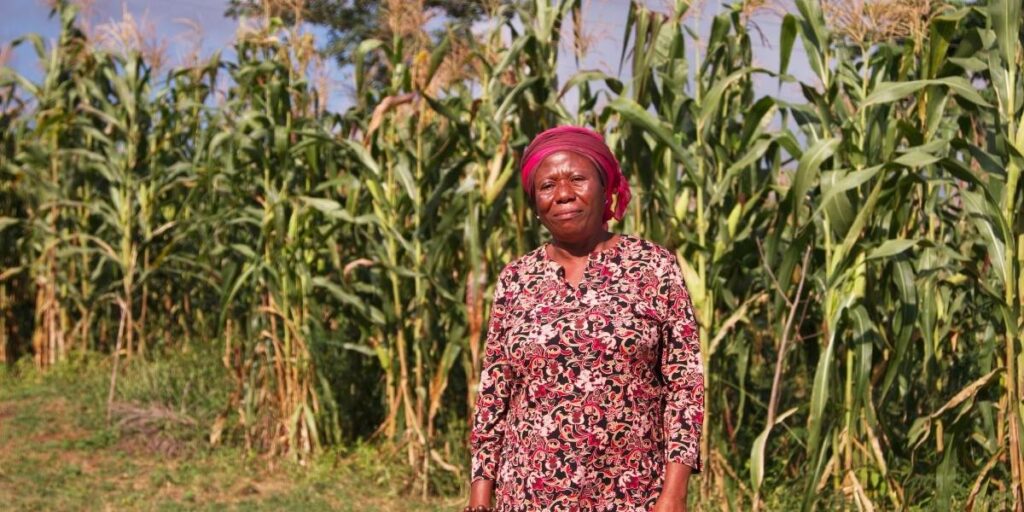Maize lethal necrosis disease (MLND) was first identified in Peru in 1973. Since then, the disease has spread rapidly to other parts of Latin America and the USA. In Africa, the disease was first reported in Kenya in 2011. By 2014, it had spread to other countries in East Africa including Tanzania, Rwanda, South Sudan, and Uganda, threatening their maize production. MLND can be devastating for farmers, causing low yields to total crop failure, and is an important food security issue.

What is Maize Lethal Necrosis Disease?
Maize Lethal Necrosis Disease (MLND) is caused by a combination of two viruses, the Maize Chlorotic Mottle Virus (MCMoV) and any of the cereal viruses in the Potyviridae group, like the Sugarcane Mosaic Virus (SCMV), Wheat Streak Mosaic Virus (WSMV) or Maize Dwarf Mosaic Virus (MDMV). The double infection of the two viruses gives rise to what is known as MLND, also referred to as Corn Lethal Necrosis (CLN).
How is MLND spread?
The disease is spread by vectors that transmit the disease from plant to plant and field to field. The most common vectors are maize thrips, rootworms, and leaf beetles. Maize is frequently grown as a mono-crop and MLND hotspots appear to be areas where maize is grown year after year without rotation.
What are the symptoms of MLND?
The disease causes a variety of symptoms in maize depending upon genotype, age of infection, and environmental conditions. Symptoms include:
– Dying leaves, leading to premature plant death
– Failure to tassel and sterility in male plants
– Malformed or no ears
– Rotting cob
What is MLND’s impact?

The disease is difficult to control for two reasons. Firstly, it is caused by a combination of two or more viruses that are difficult to differentiate individually based on visual symptoms. Secondly, the insects that transmit the disease-causing viruses may be carried by wind over long distances.
MLND poses a serious threat to maize production. In Kansas, crop losses due to MLND have been estimated to be 50-90% depending on the variety of maize and the year. In Peru, losses in floury and sweet maize varieties due to Maize chlorotic mottle virus have been reported to average between 10 and 15%.
In the hardest-hit areas of Kenya, experienced extensive or complete crop loss. The infected plants are frequently barren; the ears formed are small, deformed, and set little or no seeds, drastically reducing the yield. The areas affected constitute major maize production acreage and given the recorded loss of up to 100%, it has become an important food security issue in Kenya.
Maize Lethal Necrosis Disease management
The best approach for the management of MLND is to employ integrated pest management (IPM) practices. These include cultural control such as closed season, crop rotation and crop diversification, vector control using seed treatment followed by foliar sprays, and host-plant resistance. However, these are short-term management strategies. In the long term, both technical and programmatic interventions are required for more sustainable solutions at national and regional levels in order to halt the spread of the virus to other countries or regions.
Supporting plant health systems
You can find information on Maize Lethal Necrosis Disease on the Plantwise Knowledge Bank.
The Plantwise Knowledge Bank resources are invaluable for all actors in the plant health system, linking them to the information they need for timely action against crop pests and diseases. It supports the Plantwise goal: lose less, feed more by collecting, analyzing and disseminating pest data in order to enable:
– Identification and management of plant pests
– Protection against pest and disease threats
– Secure storage and analysis of national plant pest data
You can access the Plantwise Knowledge Bank here: Visit the Plantwise Knowledge Bank
Related News & Blogs
Horizon scanning for climate-driven pest threats can prevent biodiversity loss
On International Day for Biological Diversity, CABI’s Dr MaryLucy Oronje looks at horizon scanning and pest preparedness – approaches that help prevent the spread of invasive species, a major threat to biodiversity. Horizon scanning for invasive pests…
22 May 2025




